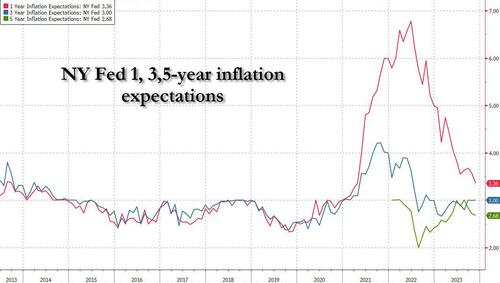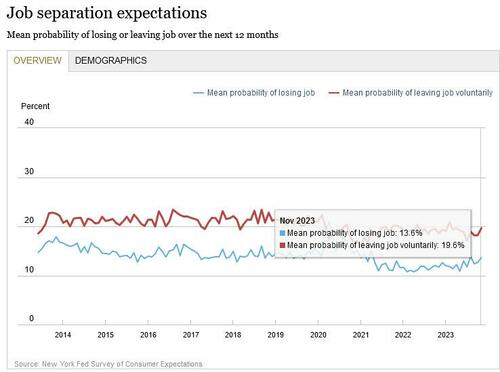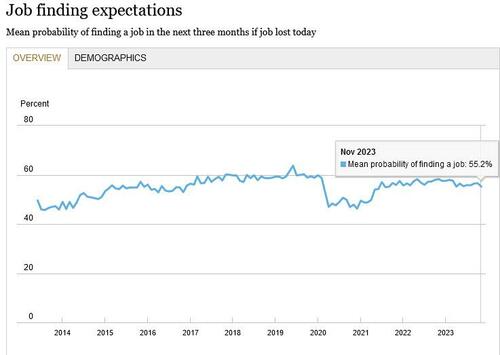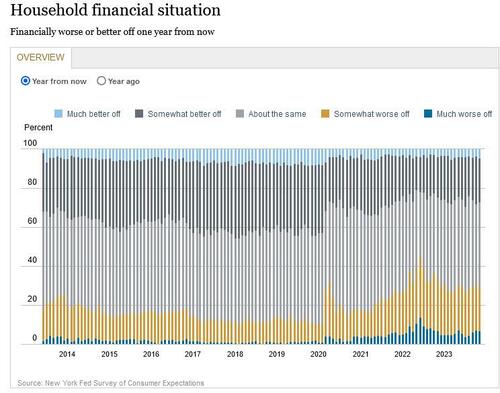
After two months of late summer increases in the 1-Year inflation expectation as tracked by the NY Fed’s monthly consumer survey, November saw the second consecutive decline in this series which traditionally is also a proxy for the price of oil, and which last month dropped to the lowest since April 2021. The drop in 1-year inflation expectations was not, however, matched by moves in the other series, as both the 3 and 5 year inflation expectations were unchanged.Here are the details: as shown in the chart below, inflation expectations at the one-year horizon decreased to 3.36% from 3.57% in October, while median inflation expectations at the three- and five-year ahead horizon remained unchanged at 3.0% and 2.7%, respectively.
Median inflation uncertainty—or the uncertainty expressed regarding future inflation outcomes—fell at the one-year ahead horizon, increased slightly at the three-year ahead horizon, and remained unchanged at the five-year ahead horizon.Amusingly, inflation views among those over age 60 retreated to a nearly three-year low, but virtually every age group was at or near a multi-year low. One almost wonders just who are these people the NY fed “randomly” calls up to “survey.”
The latest survey comes just one day before the release of November consumer price index, which also coincides with the start of the Federal Reserve’s two-day policy meeting. Economists forecast consumer prices will be unchanged in November from the prior month, helped by retreating gasoline costs.The pullback in consumers’ near-term inflation views reflected a number of factors, but most notably the price of gas: as shown in the next chart, the expected price changes for gasoline slipped, and those for both rent and a college education fell to the lowest since January 2021. Good luck with that.
Median year-ahead expected price changes decreased by 0.5 percentage point for gas to 4.5%, 0.2 percentage point for the cost of a college education to 5.8% (the lowest reading since January 2021), 1.1 percentage points for rent to 8.0% (the lowest reading since January 2021), and 0.3 percentage point for food to 5.3%, while it remained flat for medical care at 9.1%.Elsewhere, median home price growth expectations were unchanged for the second consecutive month at 3.0%. The series has remained within a narrow range of 2.8% to 3.1% since June 2023.At the same time, consumers’ views about the labor market worsened somewhat. The mean perceived probability of losing one’s job in the next 12 months increased by nearly a percentage point to 13.6%….
… while the probability of finding a job after becoming unemployed decreased to a seven-month low of 55.2%. Those in the Midwest expressed the least confidence about their chances of finding new employment.
Still what we found especially interesting is that at a time when wages are supposedly dropping, the NY Fed survey found that the average full-time job offer received in the past 4 months just hit a record high $69,475, up more than $7K in the past quarter.
Americans are also increasingly reluctant to move. The odds of changing one’s primary residence over the next 12 months dropped in November to the lowest in data back to mid-2013, which is understandable with mortgage rates still just shy of a 40 year high.
That said, several measures of household finances did improve in the month. Consumers said they were less likely to miss a minimum debt payment over the next three months…
… and respondents were more optimistic about their year-ahead financial situation.
Some more detailed from the latest report:Labor Market
Household Finance
More By This Author:Ugly, Tailing 3Y Auction Sees Lowest Foreign Demand Since June 2022Futures Flat As Yields Jump And Yen PlungesEU Policymakers Complete World’s First AI Regulatory Framework














